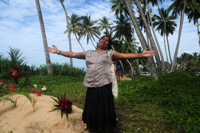NEARLY $537 million in tsunami aid for Sri Lanka is unaccounted for and more than $686m has been spent on projects unrelated to the disaster, an anti-corruption watchdog says. Berlin-based Transparency International has demanded an audit of the money received by the Sri Lankan government to help victims of the Asian tsunami that hit the island on December 26, 2004, killing 31,000 people.
As the tropical nation marked the fifth anniversary of the tsunami, the group alleged that out of $US2.2 billion ($2.5bn) received for relief, $US603.4m was spent on projects unrelated to the disaster. Another $US471.9m is missing, the group said.
"There is no precise evidence to explain the missing sum of $US471.9m," the TI statement issued in Colombo added. An "audit should be done by the government to explain the utilisation of the money received and the challenges faced", the group said.
The claims added to corruption concerns as the reconstruction effort winds down.
UN Under-Secretary General Noeleen Heyzer also voiced fears about early-warning system. Countries in the region had been working with international partners to strengthen systems but "significant gaps" needed to be addressed, he said.
The 2004 tsunami was triggered by a 9.3-magnitude earthquake off the coast of Sumatra and seismologists agree another event of that magnitude is almost certain to strike the quake-prone region.
But former US president Bill Clinton, who helped raise millions of dollars in aid for tsunami-hit nations, said Asia had "built back better" since the disaster.
"We will never forget the stories of those who lost their loved ones and all their worldly possessions in one of the worst natural disasters of our time," he said.
"Nor will we forget the tremendous international response from governments, businesses, NGOs, and private citizens who sent money, aid, and prayers in unprecedented volume to the affected regions. We did more than just build back; we built back better."
People across Asia paused over the weekend to remember the day five years ago when an undersea earthquake unleashed the devastating wave that killed more than 220,000 people.
A solemn day of prayers and remembrance to mark one of the world's worst natural disasters was held in Indonesia's Aceh province, which lost almost 170,000 people in the Asian tsunami.
At the site of one of the graves, where more than 14,000 unidentified victims are buried, an elderly woman sat on the ground weeping and reciting Koranic verses for the 40 members of her family who died.
"None of my family members survived in the tsunami. My children, grandchildren, brothers, sisters, they all have gone and left me alone here," Siti Aminah, 72, said.
Sri Lankan President Mahinda Rajapakse led remembrance ceremonies by observing two minutes of silence for tsunami victims.
Low-key commemorations marked the anniversary in southern India, which bore the brunt of the disaster in that country, with an estimated 6500 deaths.
On Marina beach in Chennai, capital of Tamil Nadu state, women from fishing hamlets poured milk into the sea and showered flower petals over the water as a mark of respect for those who died.
In Thailand, where 5395 people died, according to the official toll, ceremonies were held on the beach in Phang Nga on the west coast, which was worst hit, and on the southern island of Phuket.
AFP The Australian

















































